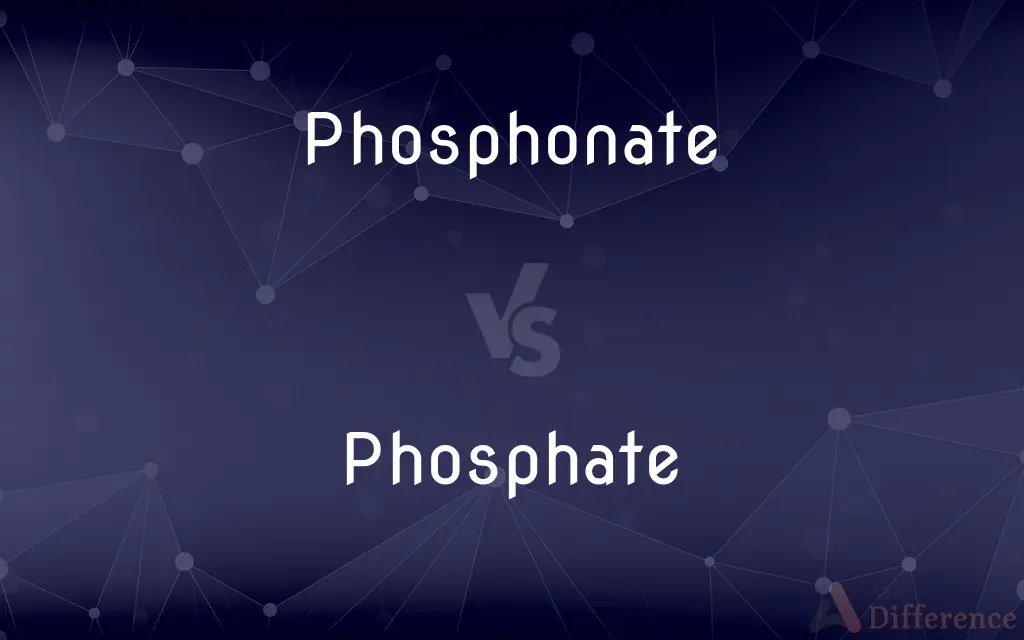Phosphonate vs. Phosphate — What's the Difference?
Edited by Tayyaba Rehman — By Urooj Arif — Updated on March 9, 2024
Phosphonate is an organophosphorus compound with a direct carbon-to-phosphorus bond, while phosphate involves phosphorus bonded to oxygen atoms.

Difference Between Phosphonate and Phosphate
Table of Contents
ADVERTISEMENT
Key Differences
Phosphonates are characterized by their C-P (carbon-to-phosphorus) bond, making them stable and resistant to hydrolysis. These compounds are used in various applications, such as scale inhibitors and antifouling agents. On the other hand, phosphates, with their P-O (phosphorus-to-oxygen) bonds, are key components in biological systems, including DNA and ATP, and are widely used in fertilizers and detergents.
The stability of phosphonates against hydrolysis and chemical breakdown makes them particularly useful in environments where long-term chemical stability is needed, such as in water treatment processes. Whereas phosphates, due to their solubility and reactivity with metals, are crucial in nutrient cycles but can contribute to environmental issues like eutrophication when overused.
In the context of industrial and household products, phosphonates are often found in cleaning agents, water softeners, and personal care products, exploiting their chelating properties to bind metal ions. Phosphates, meanwhile, have been historically used for their ability to soften water and enhance cleaning efficiency, although their environmental impact has led to decreased use in some applications.
Phosphonates also play a significant role in medicine and agriculture, serving as biocides, herbicides, and potential pharmaceutical agents due to their bioactivity and interaction with biological systems. Phosphates, in contrast, are essential for plant growth, functioning as a major plant nutrient in agriculture, but their runoff can lead to water pollution.
Despite their differences, both phosphonates and phosphates are crucial in their respective fields, with ongoing research focused on maximizing their benefits while mitigating environmental impacts. The choice between using phosphonates or phosphates often depends on the specific requirements of the application, including stability, reactivity, and ecological considerations.
ADVERTISEMENT
Comparison Chart
Chemical Bonding
Features a direct carbon-to-phosphorus (C-P) bond.
Involves phosphorus-to-oxygen (P-O) bonds.
Stability
Highly stable against hydrolysis.
Less stable, can be hydrolyzed in aqueous solutions.
Usage
Used in scale inhibitors, antifouling agents, and biocides.
Used in fertilizers, detergents, and biological systems.
Environmental Impact
Less prone to causing eutrophication; stable in various conditions.
Can contribute to eutrophication when overused.
Role in Biology
Limited natural biological role; used in medicine and agriculture.
Essential for life; components of DNA, ATP, and cellular energy.
Compare with Definitions
Phosphonate
An organophosphorus compound with a direct carbon-to-phosphorus bond.
The phosphonate-based antiscalant effectively prevented mineral deposits in the industrial water system.
Phosphate
A chemical compound containing phosphorus bonded to four oxygen atoms.
Phosphate fertilizers are essential for promoting plant growth.
Phosphonate
Known for its stability and resistance to chemical breakdown.
The chemical's phosphonate structure makes it resistant to environmental degradation.
Phosphate
Widely used in agricultural and industrial applications.
Industrial processes often use phosphates for water treatment and as flame retardants.
Phosphonate
Investigated for potential pharmaceutical applications.
Certain phosphonate compounds show promise as treatments for bone disorders.
Phosphate
Essential for DNA and RNA structure.
The backbone of DNA molecules is made up of a sugar-phosphate structure.
Phosphonate
Utilized in various applications, including water treatment and agriculture.
Phosphonate herbicides are widely used due to their selective action on weeds.
Phosphate
Can lead to environmental issues like eutrophication when concentrations are high in water bodies.
Excessive use of phosphate-based fertilizers has contributed to water pollution problems.
Phosphonate
Acts as a chelating agent, binding to metal ions.
Phosphonates in detergents capture calcium and magnesium ions, softening water.
Phosphate
Plays a crucial role in biological systems, such as energy transfer.
ATP, or adenosine triphosphate, is a key energy carrier in cells, containing three phosphate groups.
Phosphonate
Phosphonates and phosphonic acids are organophosphorus compounds containing C−PO(OH)2 or C−PO(OR)2 groups (where R = alkyl, aryl). Phosphonic acids, typically handled as salts, are generally nonvolatile solids that are poorly soluble in organic solvents, but soluble in water and common alcohols.
Phosphate
In chemistry, a phosphate is an anion, salt, functional group or ester derived from a phosphoric acid. It most commonly means orthophosphate, a derivative of orthophosphoric acid H3PO4.
Phosphonate
(chemistry) Any salt or ester of a phosphonic acid; many of its derivatives have important biological activity.
Phosphate
A salt or ester of phosphoric acid, containing PO₄³⁻ or a related anion or a group such as —OPO(OH)₂.
Phosphonate
(chemistry) To react with a phosphonic acid derivative
Phosphate
An effervescent soft drink containing phosphoric acid, soda water, and flavouring.
Phosphate
A salt, ester, or anion of phosphoric acid, derived by removal or replacement of one, two, or especially all three of the hydrogens of phosphoric acid.
Phosphate
A fertilizer containing phosphorus compounds.
Phosphate
A soda fountain drink made by blending carbonated water with flavored syrup.
Phosphate
(chemistry) Any salt or ester of phosphoric acid.
Phosphate
(agriculture) Any fertiliser containing phosphate compounds.
Phosphate
Guano (containing high levels of phosphates and harvested for the fertiliser industry).
Phosphate
A carbonated soft drink containing phosphoric acid, often flavored with a fruit-based syrup.
Phosphate
To treat or coat with a phosphate or with phosphoric acid
Phosphate
A salt of phosphoric acid.
Phosphate
A salt of phosphoric acid
Phosphate
Carbonated drink with fruit syrup and a little phosphoric acid
Common Curiosities
How do phosphates contribute to eutrophication?
Phosphates contribute to eutrophication by promoting excessive growth of algae and aquatic plants when they run off into water bodies, leading to oxygen depletion and harm to aquatic life.
Can phosphonates be used in medicine?
Yes, phosphonates have potential pharmaceutical applications, including treatments for bone disorders and as components of certain antibiotics.
How do phosphonates work as chelating agents?
Phosphonates work as chelating agents by binding to metal ions like calcium and magnesium, preventing scale formation and corrosion in water systems.
What role do phosphates play in biological systems?
Phosphates play a crucial role in biological systems by being part of DNA and RNA structures, and as molecules like ATP, which are essential for cellular energy.
Why are phosphonates considered stable?
Phosphonates are considered stable due to their resistance to hydrolysis and chemical breakdown, attributed to the strong carbon-to-phosphorus bond.
How are phosphonates and phosphates regulated?
Both phosphonates and phosphates are regulated by environmental and health safety standards to minimize their negative impacts on health and ecosystems, with regulations varying by country and application.
What makes phosphonates different from phosphates?
The key difference lies in their chemical structure: phosphonates have a carbon-to-phosphorus bond, while phosphates have phosphorus bonded to oxygen atoms, affecting their stability, applications, and environmental impact.
Why are phosphates essential in agriculture?
Phosphates are essential in agriculture because they are a major nutrient for plants, promoting root development, energy transfer, and overall growth.
What are the environmental concerns associated with phosphates?
The main environmental concern is their potential to cause water pollution and eutrophication, which can lead to danger zones in aquatic environments where most life cannot survive.
Are there alternatives to phosphates in detergents?
Yes, due to environmental concerns, alternatives to phosphates in detergents include citrates, zeolites, and phosphonates, which aim to reduce eutrophication risks while maintaining cleaning efficiency.
Share Your Discovery

Previous Comparison
Adjective vs. Adverb
Next Comparison
Macedonite vs. TitaniumAuthor Spotlight
Written by
Urooj ArifUrooj is a skilled content writer at Ask Difference, known for her exceptional ability to simplify complex topics into engaging and informative content. With a passion for research and a flair for clear, concise writing, she consistently delivers articles that resonate with our diverse audience.
Edited by
Tayyaba RehmanTayyaba Rehman is a distinguished writer, currently serving as a primary contributor to askdifference.com. As a researcher in semantics and etymology, Tayyaba's passion for the complexity of languages and their distinctions has found a perfect home on the platform. Tayyaba delves into the intricacies of language, distinguishing between commonly confused words and phrases, thereby providing clarity for readers worldwide.














































